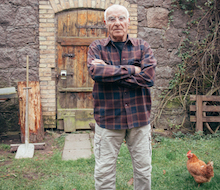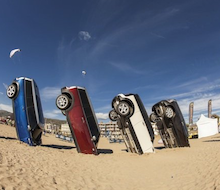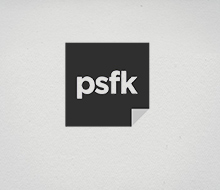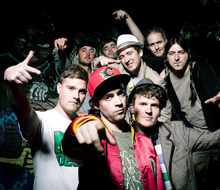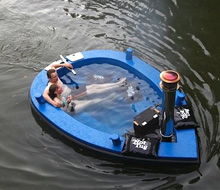We now live in the age of authenticity. What makes you tick? Show us. Stand for something? Good, be transparent about it. No more walls. But when it comes to the birds and the bees, we think we’re all aboard the “authenticity” bandwagon because rappers rap about booty in music videos and doctors no longer diagnose sexually frustrated women with “hysteria” like in the days of old. But when it comes to discussing the real issues—like the pleasure gap between males and females—that statistically, women are four times more likely to refer to sex as less pleasurable than men—some of us still have feudal-style walls and moats between us and our sexual desires.
Swooping in to the rescue is behavioral psychologist Alexandra (Alex) Fine who teamed up with product engineer Janet Lieberman to create sex toys that satisfy real women’s needs at Dame Products. Sure, sex toys are nothing new—they’ve been around for at least 25,000 years—but the need for product innovation is dire. According to Alex and Janet, an industry that ought to be empowering its customer base only seems to frustrate them with sub-par materials and poorly-executed design. Dame Products’ well-engineered sex toys Eva and Fin heighten intimacy by being designed to stay out of the way during penetrative sex, proving that inanimate objects are no substitute for people.
I sat down with Alex to discuss how and why she went on her mission to openly empower the sexual experiences of womankind and make the world a better place one vagina at a time.
You and Janet come from professional worlds that are seemingly 180 degrees apart from one another—psychology and mechanical engineering, respectively. How were the seeds initially sewn that led to both of you saying, “Let’s make a sex toy together”?
Janet and I were both young women starting sex toys companies in Brooklyn at the same time. Our backgrounds were so different that we knew we had to use it to our benefit, so we teamed up. Both of us had been looking for someone to fill the other half of the company’s void. I had spent years specializing in the study of sex. I’m a Columbia-educated expert and incredibly passionate about the subject, but I was looking for someone who knew how to get products made. Janet had been doing that for years. She is an MIT-educated mechanical engineer with seven years experience designing products and figuring out how to take a concept and get it into the hands of consumers.
When did your interest in the psychology surrounding sex first begin?
I guess I’d say when I was about seven years old when my cool aunt took me to a drag queen party. I met a bunch of amazing humans who answered all my honest questions about their gender. I presented this information to my first grade class and then my parents were called. I remember not understanding why what I had done was wrong, because I hadn’t done anything wrong. I think that really peaked my interest in gender and sex politics. Plus I was a super horny girl, so that also encouraged my interest!
Eva and Fin were designed to address the “pleasure gap”. What are the most compelling statistics or facts that support that the existence of this pleasure gap?
The pleasure gap is about the disparity between men and women and how they subjectively feel about pleasure.
The pleasure gap refers to the fact that, statistically, women are four times more likely to refer to sex as less pleasurable than men. (5% of men versus 23% of women)
Two of the most important factors of pleasure for women:
- Touching, kissing and physical contact
- Clitoral stimulation (70% of women require this!)
- Traditionally during sex, it can be difficult or awkward for a woman to get this clitoral stimulation during vaginal intercourse, and most options for facilitating this end up being intrusive and putting something in between you and your partner.
Why do you think it’s taken so long for our society to address the pleasure gap?
Well, I think society has been trying to address issues around sexuality for some time. I think the understanding that sex and gender politics impact our culture and our societal inequality isn’t new. The sexual revolution happened half a century ago (or arguably almost a century ago—since the 20s could be considered an earlier sexual revolution). However, our feelings about what is civilized and what is appropriate is so tied to sex that having a conversation that acknowledges the importance of pleasure is really really hard! I guess what I’m trying to saying is that a subset of society has been trying to address the pleasure gap for a while but getting people to think that their sexual pleasure, or their child’s eventual sexual pleasure is counter to 1,000 of years of cultural priming.
Why do you think there are less regulations for how sex toys are made?
We would need to first acknowledge that we use sex toys before regulating them. If something is seen as indecent than it is difficult to discuss in homes, in schools and certainly in government buildings.
Why is it important to you that the company is run by two females?
Because we are women and understand the concerns on a personal level, we’re able to really address these issues on a ground level. We can’t even begin to mention how many women we speak to who say “Wow, it’s not just me! I thought I was the only woman who couldn’t have internal orgasms.” Through shared experiences and open dialogue, we can begin to create options to help women feel empowered in their sexual decisions.
What are some of the big ideas and shifts that you’ve been tracking in the sex toy space in recent years?
Sex toys are nothing new—they’ve been around at least 25,000 years—so it’s just about a shift in more publicly admitting some fairly obvious things: that women like things that cause pleasure (duh), that even committed couples are not going to match perfectly in sexual desires all of the time (duh), that women not in relationships want options, too (duh), and that inanimate objects are not substitutes for people (duh).
What are the important consumer attitudes and behaviors around sex toys that you see shaping the marketplace?
On top of that, the overall acceptance of technology in society right now certainly helps, especially since geek chic itself has become such a trendy subject. Approaching sex toys through that angle is particularly appealing for many people. We’re also very adamant that we neither sensationalize or sweep the subject under the rug by adopting a very straight-forward approach, which I think in this age of authenticity is very alluring as well.
Any predictions about the direction the sex toy industry might take in the next 10-20 years in terms of technology, trends and approaches? What do you think will be the biggest changes in the industry?
I think that the intersection of sex and technology is in a unique space in that sex represents the most intimate and animalistic aspect of humanity while tech represents a very man-made aspect of humanity. Tech often helps us disengage from reality while sex is all about engaging in reality. I do think teledildonic is super cool and can really help people faraway feel connected. That being said, I’m not sure that it would ever replace actually having sex or that long distance relationships are all of sudden going be easuer just because we have better technology. I think we are going to see more teledildonics, virtual reality pornography, better sex robots in the next decade or so, but I also think simple tools aren’t going anywhere. In fact, crystal dildos are on the rise.
What does Eva and Fin offer that other products (like WeVibe) don’t?
I think that other products, like WeVibe, are important players in the industry. They are definitely helping more people have more pleasure. Unlike other companies, they really put in the capital to make a product right and perhaps for some people, the WeVibe could be a better solution than Eva or Fin. I think we offer different products that do a slightly different job than our competitors. I also like to think we are doing a better job at engaging in the dialogue around sex.
What’s the biggest thing you’ve learnt about the sex toy field since you started out?
When I think about the future of the discussion around sex, I worry about the gamification of sex and how awful that could be. The last thing we need is competitive orgasmathons! Our pleasure experiences are subjective and the idea of using sensors to quantify a subjective and personal experience just makes me uncomfortable. I do think much of that is a phase, though, and that what all of the excitement around this genre is really showing is that people and professionals are finally normalizing sex toys as a consumer electronic product instead of an oddity or a novelty.
What’s the biggest thing you’ve learnt about yourself?
I’ve learned that at the end of the day I have to live with my actions and that knowing my own intentions and goals is a challenge within itself. I’ve also learned that some people who seem successful are just lucky. I’m amazed by the amount of people who have gotten where they are primarily due to circumstances outside of their control yet do not acknowledge it.
What advice would you give to young women who aren’t receiving reciprocal pleasure in sex?
I would tell them that there is nothing wrong with them or their bodies. I’d encourage them to masturbate, to learn more about their bodies and desires. And I would also encourage them to tell their partners that they aren’t experiencing pleasure during sex. It isn’t an easy conversation. Women have been faking orgasms for a very long time in order to avoid that conversation but everyone deserves pleasure. It’s all about being present and letting go.
What’s the best piece of advice you could give to people out there trying to innovate in the sex toy space?
Validate your concepts as quickly as possible. Don’t spend a ton of money and time developing something that only 15% of women out there want.
What can we expect next from Dame Products? Are there any new works in progress?
We are working hard to both improve our products, make new ones and research what people want. Right now Eva 2 is taking up most of our time.






